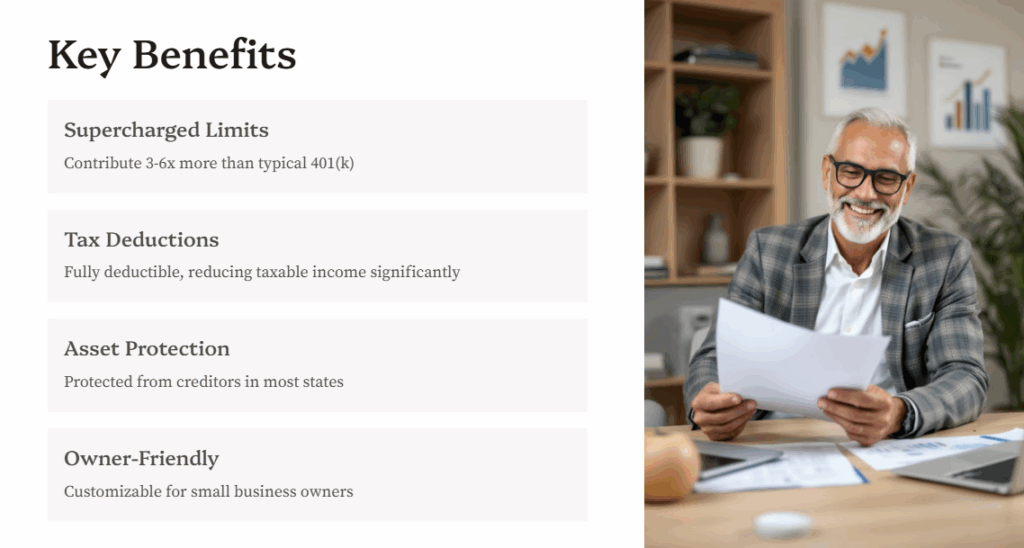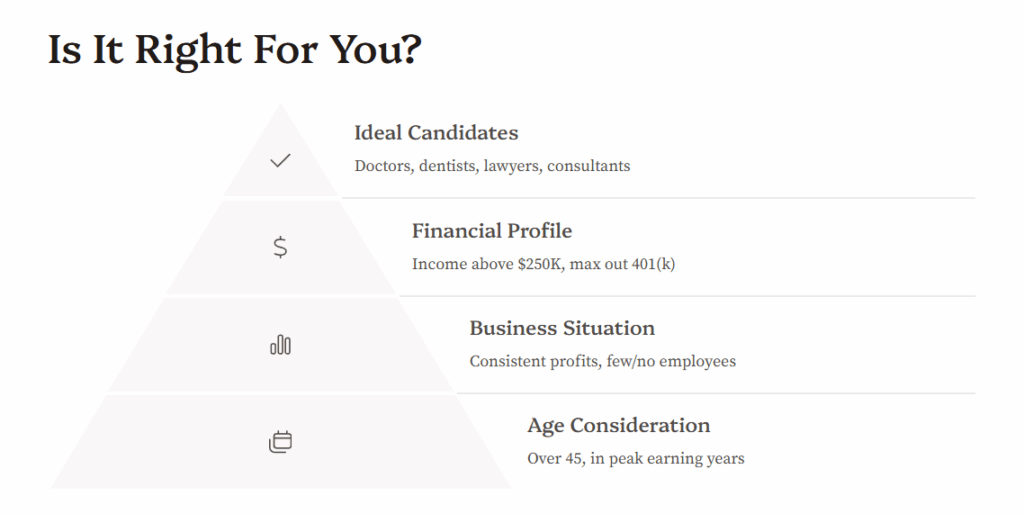If you’re a high-income professional looking to save more for retirement and reduce your taxable income, you’ve likely already hit your 401(k) limit. So what’s next? Enter the Cash Balance Pension Plan—a powerful retirement tool that can allow you to contribute well into six figures annually, all while slashing your tax bill.
In this post, we’ll break down what the cash balance pension retirement plan contribution limits are, who qualifies, and how two high-income professionals use this strategy to their advantage. If you’re earning $200,000 or more per year, this might be the most valuable retirement strategy you’ve never heard of.
What Is a Cash Balance Pension Plan?
A cash balance plan is a type of defined benefit retirement plan that works like a hybrid between a traditional pension and a 401(k). While a 401(k) has contribution limits around $69,000–$76,500 (for those over 50 in 2025, including employer match), a cash balance plan can allow contributions of over $300,000 per year, depending on your age and income.
Unlike a traditional pension that pays out based on years worked, a cash balance plan assigns each participant a “hypothetical account” that grows annually with two types of credits:
- Pay credit (e.g., 5% of compensation)
- Interest credit (fixed or variable based on IRS-published rates)
2025 Cash Balance Pension Retirement Plan Contribution Limits
Contribution limits are age-based and increase significantly the closer you are to retirement age. Here’s a rough breakdown for 2025 (exact limits may vary slightly by actuarial assumptions and plan design):
| Age | 401(k) w/ Profit Sharing (401(k) only) | Cash Balance | Total (Tax Savings) |
|---|---|---|---|
| 30-34 | $70,000 ($23,500) | $81,000 | $151,000 ($67,900) |
| 35-39 | $70,000 ($23,500) | $103,000 | $173,000 ($77,800) |
| 40-44 | $70,000 ($23,500) | $132,000 | $202,000 ($90,900) |
| 45-49 | $70,000 ($23,500) | $170,000 | $240,000 ($108,000) |
| 50-54 | $77,500 ($31,000) | $218,000 | $295,500 ($132,900) |
| 55-59 | $77,500 ($31,000) | $280,000 | $357,500 ($160,800) |
| 60-65 | $77,500 ($31,000) | $342,000 | $419,000 ($188,700) |
| 66-70 | $77,500 ($31,000) | $383,000 | $460,500 ($207,200) |
Note: These total contributions are in addition to your 401(k) and profit-sharing plan limits.
How High-Income Professionals Use Cash Balance Plans
Let’s look at two practical simulations based on actual financial profiles.
Case 1: 50-Year-Old Financial Consultant
- Age: 50
- Occupation: Solo Financial Consultant (LLC)
- Net Income: $400,000
Retirement Contributions:
| Plan Type | Contribution Amount |
|---|---|
| 401(k) + Profit Sharing | $77,500 |
| Cash Balance Plan | $218,000 |
| Total | $295,500 |
Estimated Tax Savings:
If this individual is in a combined federal + state tax bracket of 40%, they could save over $140,000 in taxes this year alone—while building retirement wealth.
Case 2: 60-Year-Old Ophthalmologist
- Age: 60
- Occupation: Owner of a small ophthalmology practice
- Net Income: $600,000
Retirement Contributions:
| Plan Type | Contribution Amount |
|---|---|
| 401(k) + Profit Sharing | $77,500 |
| Cash Balance Plan | $342,000 |
| Total | $457,500 |
Estimated Tax Savings:
With a similar tax bracket (or even higher in states like California or New York), this ophthalmologist could save over $180,000 in taxes, while setting aside nearly half a million dollars for retirement in one year.
Key Benefits of Cash Balance Pension Plans
1. Supercharged Contribution Limits
You can contribute 3–6x more than a typical 401(k), especially after age 50.
2. Massive Tax Deductions
Contributions are fully deductible to the business, reducing taxable income significantly.
3. Asset Protection
In most states, assets in a qualified retirement plan like this are protected from creditors.
4. Customizable for Owners
Small business owners, especially those with no or few employees, can tailor the plan to prioritize their own retirement savings.

What to Watch Out For
1. Annual Actuarial Requirements
You’ll need to work with an actuary to maintain the plan each year (usually $2,000–$5,000 annually in admin costs).
2. Required Contributions
Once implemented, contributions are generally expected each year. This is not a “turn on, turn off” plan.
3. Employee Nondiscrimination Testing
If you have employees, you must contribute to their accounts too, following IRS fairness rules. That’s why this plan is often ideal for solo or owner-only businesses.
4. Mandatory IRS Filings
You’ll need to file IRS Form 5500 annually. Mistakes here can result in penalties.
Is It Right for You?
If you check off most of these boxes, a cash balance plan could be a strategic fit:
- You’re over 45
- You have net income above $250,000
- You already max out your 401(k)
- You have consistent profits and cash flow
- You’re interested in long-term retirement and tax planning
It’s especially ideal for:
- Doctors, dentists, lawyers, and consultants
- Business owners with no or few employees
- Professionals in their peak earning years looking to catch up on retirement

Final Thoughts
The cash balance pension retirement plan contribution limits offer one of the most powerful opportunities for high earners to reduce taxes while investing aggressively for retirement. It’s not for everyone—but if you’re a business owner in your 50s or 60s with consistent earnings and a desire to keep more of your money, this is worth serious consideration.
Tip: Talk to a retirement plan specialist or financial advisor who can design a custom plan that maximizes deductions while staying IRS-compliant.
🔗 Useful Resources
- [1]U.S. Department of Labor, Cash-Balance-Pension-Plan-FAQ PDF
- [2]U.S. Department of Labor, Fact Sheet: Cash Balance Pension Plans PDF
- 2025 Amounts Relating to Retirement Plans and IRAs, as Adjusted for Changes in Cost-of-Living PDF
- 401(k), IRA, and Roth IRA: Which Retirement Plan Is Best?


